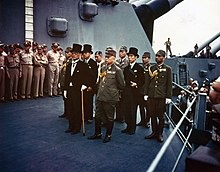Yoshijirō Umezu
Yoshijirō Umezu | |
|---|---|
梅津美治郎 | |
Shōwa | |
| Preceded by | Kenkichi Ueda |
| Succeeded by | Otozō Yamada |
| Personal details | |
| Born | January 4, 1882 Imperial Japanese Army General Staff |
| Battles/wars | Russo-Japanese War World War II |
Yoshijirō Umezu (梅津 美治郎, Umezu Yoshijirō) (January 4, 1882 – January 8, 1949) was a Japanese general in World War II and
Biography
Early life and career
Umezu was born in Nakatsu, Ōita, Japan, where his family ran a bookstore since the 18th century. During his years at the Kumamoto Prefectural Seiseikou High School in Kumamoto, he decided to pursue a military career. He graduated from the 15th class of the Imperial Japanese Army Academy on November 30, 1903, and was commissioned a second lieutenant in the infantry the following February 12, 1904. Promoted to lieutenant on June 30, 1905, he entered the 23rd class of the Army Staff College, graduating first in 1911. Following his promotion to captain on March 25, 1912, he was sent to Europe for further studies in Germany and Denmark. While in Denmark, he was also a military observer from Japan, during the course of World War I, and was promoted to major on June 1, 1918. From 1919 to 1921, he was appointed as a military attaché to Switzerland.[1]
Umezu was promoted to lieutenant colonel on February 8, 1922, and to colonel on December 15, 1925. During the 1920s, he was a member of the
Umezu was promoted to
World War II

Umezu returned to China in May 1938 as
In July 1944, Umezu was appointed as the final Chief of the
After the war, he was arrested by the
Umezu died from


Decorations
- 1906 –
 Order of the Rising Sun, 6th class [8]
Order of the Rising Sun, 6th class [8] - 1906 –
 Order of the Golden Kite, 5th class [8]
Order of the Golden Kite, 5th class [8] - 1913 –
 Order of the Sacred Treasure, 5th class [9]
Order of the Sacred Treasure, 5th class [9] - 1915 –
 Order of the Rising Sun, 4th class [8]
Order of the Rising Sun, 4th class [8] - 1922 –
 Order of the Sacred Treasure, 3rd class [8]
Order of the Sacred Treasure, 3rd class [8] - 1933 –
 Order of the Sacred Treasure, 2nd class [8]
Order of the Sacred Treasure, 2nd class [8] - 1936 –
 Grand Cordon of the Order of the Sacred Treasure[8]
Grand Cordon of the Order of the Sacred Treasure[8] - 1939 –
 Grand Cordon of the Order of the Rising Sun[8]
Grand Cordon of the Order of the Rising Sun[8] - 1940 –
 Order of the Golden Kite, 2nd class[8]
Order of the Golden Kite, 2nd class[8]
References
- Butow, Robert J. C. (1954). Japan's Decision to Surrender. Stanford University Press. ASIN: B000VFCC14.
- Dupuy, Trevor N. (1992). Encyclopedia of Military Biography. I B Tauris & Co Ltd. ISBN 1-85043-569-3.
- Frank, Richard B. (1999). Downfall: the End of the Imperial Japanese Empire. Penguin, non-classics. ISBN 0-14-100146-1.
- Fuller, Richard (1992). Shokan: Hirohito's Samurai. London: Arms and Armor. ISBN 1-85409-151-4.
- Hayashi, Saburo; Cox, Alvin D (1959). Kogun: The Japanese Army in the Pacific War. Quantico, Virginia: The Marine Corps Association.
- Kase, Toshikazu (1950). Journey to the Missouri.
- Maga, Timothy P. (2001). Judgment at Tokyo: The Japanese War Crimes Trials. ISBN 0-8131-2177-9.
Notes
- ^ Dupuy, Encyclopedia of Military Biography
- ^ Ammenthorp, the Generals of World War II
- ^ Budge, Pacific War Online Encyclopedia
- ^ Butow, Japan's Decision to Surrender
- ^ Shokan, Hirohito's Samurai
- ^ Maga, Judgement at Tokyo
- ^ a b ""Japanese Convert" - The West Australian (Perth, WA : 1879 - 1954)". trove.nla.gov.au. January 11, 1949. Retrieved January 15, 2024.
- ^ a b c d e f g h https://dl.ndl.go.jp/info:ndljp/pid/10273436
- ^ 『官報』第251号「叙任及辞令」June 2, 1913
External links
- USS Missouri Archived February 10, 2006, at the Wayback Machine
- Ammenthorp, Steen. "Umezu, Yoshijiro". The Generals of World War II.
- Budge, Kent. "Umezu, Yoshijiro". Pacific War Online Encyclopedia.
- Clancy, Patrick. "HyperWar:IMTFE Judgement". HyperWar Foundation.
